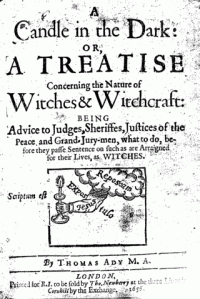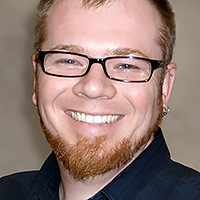Thomas Ady was an English doctor and critical exposer of both persecutions for alleged witchcraft and the type of faux-paranormal scams, such as fortunetelling, that sometimes led to witchcraft trials. He was especially critical of the use of torture (including sleep deprivation1) in those trials. But some victims of witch trials confessed without coercion. Ady reflected on those poor souls as follows:
Some indeed have in a melancholly distraction of minde confessed voluntarily, yea and accused themselves to bee Witches, that could do, and had done such strange things, and wonders by the help of the Devil; but mark well their distemper, and you shall finde that they are deeply gone by infirmity of body affecting the minde, whereby they conceit such things as never were, or can be, as is often proved by experience among Physicians, many of those dying in a very short time, (although they be not put to death) except they be cured by the Physician; and truly if such Doctrins had not been taught to such people formerly, their melancholly distempers had not had any such objects to work upon, but who shall at last answer for their confession, but they that have infected the mindes of common people with such devillish doctrins, whereby some are instigated to accuse their poor Neighbours of impossibilities contrary to the Scriptures, and some drawn to confess lyes, and impossibilities contrary to Christian light?

Cover from the 1656 edition, which was pointedly framed as “Advice to Judges, Sheriffes, Justices of the Peace, and Grand-Jury-men, what to do, before they passe Sentence on such as are Arraigned for their Lives as Witches.”
Ady’s causal question anticipated conversations that continue to this day, both in the skeptical world and in the wider culture. Skeptics observe harm resulting from paranormal and pseudoscientific beliefs, but struggle to measure that harm or to determine how the world might be different in the absence of those beliefs. Cultural critics wonder (for example), where is the line between the innate dispositions of terrorists, their cultural and political milieu, and their religious mania? Can “melancholly distempers” be disentangled from “devillish doctrins” that “infected the mindes”? How? And to what degree?
Whatever the answers, we should not be surprised that Ady asked such questions. One of the ongoing themes of my career is that the work of scientific skepticism—the critical, evidence-based study of allegedly paranormal phenomena and fringe science claims—is very old.3 In all times there are scams, misunderstandings, claims, mysteries, and stories of wonder; in all times there are those who feel an impulse to sift these for whatever facts there are to be found. Sometimes that impulse takes on a life and death urgency, as when Ady’s Candle in the Dark was used (unsuccessfully) in defense during the Salem witch trials.
Ady’s three and a half centuries-old book is a treasure trove for modern skeptics. A Candle in the Dark is a hardcore skeptics book even by modern standards—so much so, that Carl Sagan borrowed Ady’s title for his own 1996 classic, The Demon-Haunted World: Science as a Candle in the Dark.4 Here’s how I’ve previously described Ady’s book:
Ady was a Christian, and actually did believe that “witches” existed—but his definition took me by surprise. In Ady’s view, genuine witches were not supernatural, but humans who led other people into idolatry or away from a proper understanding of god—especially by performing bogus miracles. His witches were phony paranormal claimants, many of exactly the same types skeptics expose today. Ady described several classes of psychic scam, and even some of the techniques that made them possible. Some con artists pretended to receive prophetic messages or insight by some system of divination, “yet it was altogether a cozening imposture, or uncertain guessing, or conjecturing” (Ady mentions some who cast bones, and others who “observed the entrails of beasts, from whence they pretended they did know the will of the gods”). Like modern skeptical magicians, Ady poured scorn on those who performed the tricks of stage magic under the pretense that they were genuine miracles. These scammers, Ady wrote, accomplished their deceit through sleight of hand, through confederacy (“that is, when many or a few agents do agree together in bringing to pass cheating impostures”) and through the cunning “abuse of their knowledge of natural causes….” Ady described routines and props for a number of magician’s tricks in detail, and then—in a remarkable moment of skeptical history—argued that stage magicians have a useful role in debunking bogus miracle-mongers. The real trouble does not come from performers “who play their tricks in fairs and markets, nor gentlemen who sometimes in imitation of them, do in sport, play tricks of sleight of hand, or legerdemain, with confederates or without,” Ady argued; indeed, “it is most certain and true, that if it be rightly understood, that these do a great deal of good, that recreation tending rightly to the illumination of people of all sorts, to show them the vanity and ridiculousness of those delusions and lying wonders, by which men were so easily deluded….” Beyond this prescient suggestion of the shape of skepticism to come, Ady went on to expose moving statues (controlled by wires) weeping icons (fed by pipes) bogus spirit mediumship (disguised voices from concealed confederates) and so on.5
References
- “[O]ne of the most devillish cruelties that hath been devised among men, and that is, to keep the poor accused party from sleep many nights and days, thereby to distemper their brains, and hurt their fancies, at length to extort confession from them, and then to bring their own confession as an evidence against them….” Thomas Ady. A Candle in the Dark: Shewing The Divine Cause of the Distractions of the whole Nation of England, and of the Christian World. (London: Printed for Robert Ibbitson, 1655.) p. 99
- Ibid. p. 99. 124–125
- See for example my 2013 historical exploration “Why Is There a Skeptical Movement?” (PDF), or my 2014 speech “A Rare and Beautiful Thing” (read the text or watch the video).
- For those familiar with the Sagan book, Sagan discusses Ady right in between two famous passages that are sometimes combined:
We’ve arranged a global civilization in which most crucial elements profoundly depend on science and technology. We have also arranged things so that almost no one understands science and technology. This is a prescription for disaster. We might get away with it for a while, but sooner or later this combustible mixture of ignorance and power is going to blow up in our faces.
and,
I worry that, especially as the Millennium edges nearer, pseudoscience and superstition will seem year by year more tempting, the siren song of unreason more sonorous and attractive. Where have we heard it before? Whenever our ethnic or national prejudices are aroused, in times of scarcity, during challenges to national self-esteem or nerve, when we agonize about our diminished cosmic place and purpose, or when fanaticism is bubbling up around us – then, habits of thought familiar from ages past reach for the controls.
The candle flame gutters. Its little pool of light trembles. Darkness gathers. The demons begin to stir.
- Daniel Loxton. “Why Is There a Skeptical Movement?” (Skeptics Society, 2013) pp. 22–23. Read the PDF here. (Note that the spelling given in the quotes included in this passage may be slightly modernized.)











‘Phony paranormal claimants” (per Ady) can and do exist and pretend all kinds of things. It’s good to see/hear anyone identify them as such (I belong to a group, the I.I. G. which investigates any such claims); but it seems odd, almost perverse, and entirely hypocritical, to hear it from a `Christian’.
In part because of Biblical injunctions against fortunetelling, there is a long Christian tradition of debunking and exposing supposedly paranormal abilities and phenomena. I’ve previously written, for example, about Father Carlos M. de Heredia—a practicing Jesuit priest, magician, and media skeptic active during the early twentieth century.
As well, it’s important to note that the fully modern skeptical movement was created by people of faith as well as by nonbelievers. Consider for example the influence of Harry Houdini, Martin Gardner, William Jarvis (a Seventh-day Adventist), or Steve Allen.
It is worth noting that because this book is long out of copyright, scans of it can be found online. One exists at Cornell’s website here. Both facsimiles of the page and text can be accessed via that link.